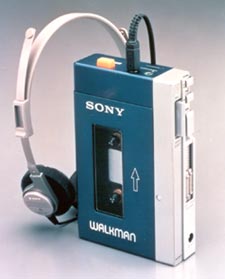Walkman: Difference between revisions
No edit summary |
No edit summary |
||
| (7 intermediate revisions by 4 users not shown) | |||
| Line 1: | Line 1: | ||
[[Image:Walkman.jpg|thumb|right|The Sony Walkman, introduced in 1979, offers highly portable—and highly private—music. Courtesy: Sony Corporation]] | |||
The first Walkman, a portable cassette player, was introduced by Sony in Japan in 1979 and became an instant success. It was introduced in the United States later that year and sparked a phenomenon in New York City that quickly spread across the country. The Walkman’s high cost made the initial market fairly affluent music fans in their mid-20s. Later, the popularity of the device spread among a wider group of consumers as the price came down. Competing products from other companies soon appeared, and by the middle 1980s there was a large range of Walkman-like players ranging in price from about $20 to well over $200. | The first Walkman, a portable cassette player, was introduced by Sony in Japan in 1979 and became an instant success. It was introduced in the United States later that year and sparked a phenomenon in New York City that quickly spread across the country. The Walkman’s high cost made the initial market fairly affluent music fans in their mid-20s. Later, the popularity of the device spread among a wider group of consumers as the price came down. Competing products from other companies soon appeared, and by the middle 1980s there was a large range of Walkman-like players ranging in price from about $20 to well over $200. | ||
At the beginning, the Walkman came with a leather case and headphones. Among other features it had a second earphone jack to spread the sound into two sets of headphones; the two listeners could also talk to each other through a microphone. The name “Walkman” might have been derived from the initial idea behind the machine—to use it while moving about (especially walking). | At the beginning, the Walkman came with a leather case and headphones. Among other features it had a second earphone jack to spread the sound into two sets of headphones; the two listeners could also talk to each other through a microphone. The name “Walkman” might have been derived from the initial idea behind the machine—to use it while moving about (especially walking). | ||
| Line 17: | Line 9: | ||
Since its invention, the Walkman has appeared in many different styles and with various features to meet the tastes and demands of the consumers, many of whom used it while engaged in a physical activity. There have been dozens of variations on the basic Walkman tape player, including models that included AM and FM radios, models that were radios only, and models that played compact discs. | Since its invention, the Walkman has appeared in many different styles and with various features to meet the tastes and demands of the consumers, many of whom used it while engaged in a physical activity. There have been dozens of variations on the basic Walkman tape player, including models that included AM and FM radios, models that were radios only, and models that played compact discs. | ||
The use of the Walkman also promoted the purchase of audio tapes. Since most Walkmans could only play back tapes (not record them), its use helped propel sales of pre-recorded cassettes. With help from the Walkman, the sales of cassette tapes surpassed those of vinyl records in 1983. | The use of the Walkman also promoted the purchase of audio tapes. Since most Walkmans could only play back tapes (not record them), its use helped propel sales of pre-recorded cassettes. With help from the Walkman, the sales of [[Cassette Tapes|cassette tapes]] surpassed those of [[LP and 45 RPM Records|vinyl records]] in 1983. | ||
[[Category:Engineering_and_society]] | |||
[[Category:Leisure]] | |||
[[Category:Music]] | |||
Latest revision as of 20:00, 28 September 2015
The first Walkman, a portable cassette player, was introduced by Sony in Japan in 1979 and became an instant success. It was introduced in the United States later that year and sparked a phenomenon in New York City that quickly spread across the country. The Walkman’s high cost made the initial market fairly affluent music fans in their mid-20s. Later, the popularity of the device spread among a wider group of consumers as the price came down. Competing products from other companies soon appeared, and by the middle 1980s there was a large range of Walkman-like players ranging in price from about $20 to well over $200.
At the beginning, the Walkman came with a leather case and headphones. Among other features it had a second earphone jack to spread the sound into two sets of headphones; the two listeners could also talk to each other through a microphone. The name “Walkman” might have been derived from the initial idea behind the machine—to use it while moving about (especially walking).
Despite rival products, it was the Walkman that became universally associated with any personal portable tape player. Sony estimates that by now it has already sold about 100 million of the devices—a large number that does not include the equivalent products of other audio electronic companies.
Since its invention, the Walkman has appeared in many different styles and with various features to meet the tastes and demands of the consumers, many of whom used it while engaged in a physical activity. There have been dozens of variations on the basic Walkman tape player, including models that included AM and FM radios, models that were radios only, and models that played compact discs.
The use of the Walkman also promoted the purchase of audio tapes. Since most Walkmans could only play back tapes (not record them), its use helped propel sales of pre-recorded cassettes. With help from the Walkman, the sales of cassette tapes surpassed those of vinyl records in 1983.
